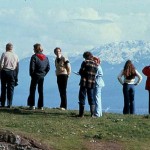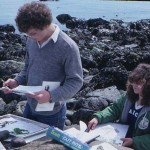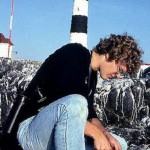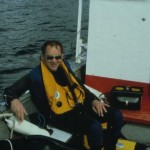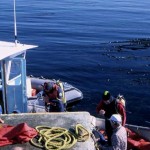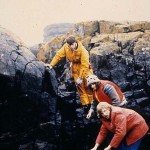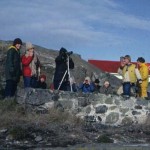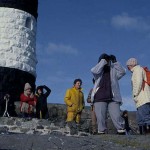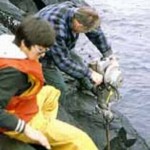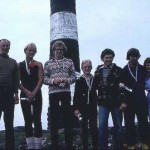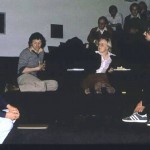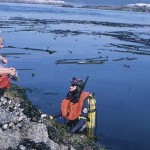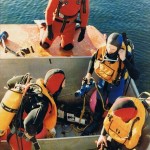
News/Reports
History of Race Rocks Ecological Reserve
Garry Fletcher wrote this history in 1996 for the Race Rocks website:
| In the fall of 1978, a small group of students of Lester B. Pearson College who were in marine science and diving, together with their teachers, Garry Fletcher and Marks McAvity and with the urging of the light keepers at Race Rocks, Trev and Flo Anderson, set about the task of seeking some form of permanent protection for the underwater and above water ecosystem at Race Rocks. The director of Parks for the Province of British Columbia, Tom Lee recommended that our concerns might be met by seeking Ecological Reserve Status for the area. He gave us the name of Dr. Bristol Foster who was then head of the Ecological Reserve Unit of the Ministry of Lands, Parks and Housing and we invited him to come out to dive with us at Race Rocks. Bristol was as impressed as we were with what he saw underwater and he urged us to set in motion the process that could lead to the creation of a marine ecological reserve for the area. Ecological Reserves had been started in B.C. only a few years earlier. They were created in order to preserve unique or representative ecosystems in the province that could serve for research and education and serve as baselines for monitoring ecological change with the encroachment of humans into natural areas.Our aim initially was to do as many scuba dives as possible covering the area around Race Rocks and document the life forms there. We also set as a goal the researching of as many aspects of the area as we could. We were able to invite Dr. Paul Breen from the Pacific Biological Station to dive with us and provide a letter of support about the richness of the species diversity at Race Rocks. Our ultimate aim was to host a workshop at Pearson College that would present our information to the B.C. government in order to urge them to get reserve status for the area. |
|
In February of 1979 a highly successful workshop took place, and the officials invited from the Provincial Museum, the University of Victoria, and the Ministry of Parks were all enthusiastic and supportive of our proposal. (The research presented then is included in the Race Rocks Archives at Pearson College Library, as is other information following the process of creating the reserve and the follow-up involvement of the college since that time.) This link details the program of that workshop. Over the next year we worked at the task of formalizing our proposal, presenting it to cabinet and lobbying to get action. Two students in diving and marine science, Johan Ashuvud from Sweden and Jens Jensen from Denmark were especially relentless in their pursuit of our goal. The proposal had to clear 11 agencies in the government bureaucracy and the cabinet before the Reserve could be proclaimed. These two students invited the Deputy Minister of Parks out to dive and then kept following it up with phone calls, even after hours! Their persistence finally paid off when after a year, the shortest time any reserve proposal has ever taken, the Minister of Parks was able to request Prince Charles on his visit to the college as international board president (April 1980) to make the formal announcement proclaiming Race Rocks the 97th Provincial Ecological Reserve.The role of the college didn’t cease then. We had volunteered to take an active role in the stewardship of the ecological reserve so in the fall of that year a current meter was obtained from The Institute of Ocean Sciences to obtain data that would form the basis of the Race Passage Tables in the Canadian Tides and Currents Book. Garry Fletcher was appointed the Volunteer Warden of the reserve, to be assisted by the students and staff of Pearson College. Dr. Theo Dombrowski , a faculty member of the English Department at Pearson has also been instrumental in helping the students to further their ecological work on the reserve. We assisted Robin Baird of the Biology Department , Simon Fraser University to install a hydrophone for his research on marine mammals, and we installed baseline transect reference pegs in 14 locations around the main island. We continue to add to our data on intertidal and subtidal transects. |
| In 1986 we started our association with Dr. Anita Brinkmann-Voss, collecting specimens and providing her with transport to the island for her work on hydroids. Her work has resulted in the identification of over 60 species of hydroid in the reserve and the naming of a new species from the reserve, with others pending further work for possible new species status, along with many new records for North America. To date nine extended essays in Biology or Environmental Systems have been done at Race Rocks by Pearson College students. Over 800 students of Biology, Marine Science or Environmental Systems have done field trips to Race Rocks for the study of intertidal transect technique, tidepool study, or synecological studies. One student also put together a herbarium collection of the marine algae from the reserve. We have been able to conduct guided ecology tours for over 150 grade seven students from the local community each year since the mid nineteen eighties. In the spring of most years we also host a tour of the reserve for the Friends of Ecological Reserves from Victoria. In 1990 we were able to secure an added measure of protection for all ground fish in the reserve by petitioning for and being granted a closure on all commercial fishing and sports fishing except for migratory salmon and Halibut. This was the first such closure of any marine reserve area on this coast that has been granted by federal fisheries.In the fall of 1992 we assisted the Royal British Columbia Museum in the live production of 24 one hour television shows from the Race Rocks Ecological Reserve. These involved 13 of our divers as well as several faculty for this first Canadian Underwater Safari production. These ecology programs were broadcast live by satellite to down-link sites in Eastern and Western Canada and in the Eastern US. Since that time they have been re -broadcast by cable stations throughout the country. It has been estimated that they have been seen by at least 2 million viewers.For an update and continuation of the history of conservation of the area in more recent times, Go to these files:
Garry Fletcher, 1996
|

